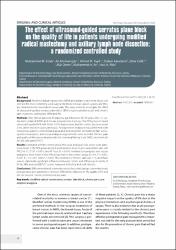| dc.contributor.author | Sulak, Muhammet Mustafa | |
| dc.contributor.author | Ahıskalıoğlu, Ali | |
| dc.contributor.author | Yayık, Ahmet Murat | |
| dc.contributor.author | Karadeniz, Erdem | |
| dc.contributor.author | Çelik, Mine | |
| dc.contributor.author | Demir, Ufuk | |
| dc.contributor.author | Arı, Muhammet Ali | |
| dc.contributor.author | Alıcı, Hacı Ahmet | |
| dc.date.accessioned | 2022-04-22T11:44:46Z | |
| dc.date.available | 2022-04-22T11:44:46Z | |
| dc.date.issued | 2022 | en_US |
| dc.identifier.citation | Sulak, M. M., Ahıskalıoğlu, A. Yayık, A. M., Karadeniz, E., Çelik, M., Demir, U. ... Alıcı, H. A. (2022). The effect of ultrasound-guided serratus plane block on the quality of life in patients undergoing modified radical mastectomy and axillary lymph node dissection: A randomized controlled study. Anaesthesiology Intensive Therapy, 54(1), 48-55. https://doi.org/10.5114/ait.2022.114203 | en_US |
| dc.identifier.issn | 1731-2531 | |
| dc.identifier.uri | https://doi.org/10.5114/ait.2022.114203 | |
| dc.identifier.uri | https://hdl.handle.net/20.500.12511/9360 | |
| dc.description.abstract | BACKGROUND: Modified radical mastectomy (MRM) and axillary lymph node dissection (AD) are the most commonly used surgical methods in breast cancer surgery, and they are characterized by moderate to severe pain. This study aimed to investigate the effect of ultrasound-guided serratus plane block (SPB) on postoperative acute and chronic pain in patients undergoing MRM and AD. METHODS: After ethical approval, 60 patients, aged between 18-65 years, ASA I-III, underwent unilateral MRM, and AD was assigned into 2 groups. The SPB group received ultrasound-guided SPB with 30 mL 0.25% bupivacaine, and the control group received 2 mL saline injection subcutaneously. Postoperative analgesia was performed with intravenous patient-controlled analgesia and dexketoprofen trometamol. Pain scores, opioid consumption, and rescue analgesic requirements were recorded. Chronic pain and quality of life were evaluated with the Numerical Rating Scale (NRS), short form-36 (SF-36), and painDETECT. RESULTS: Compared with the control group, the visual analogue scale scores were statistically lower in the SPB group during 4 postoperative hours in post-anaesthetic care unit PACU at 1st, 2nd (P < 0.001), and 4th hour (P = 0.014). Fentanyl consumption and rescue analgesics were lower in the SPB group than in the control group (0-4 h, P = 0.001; 4-8 h, 8-12 h, 24 h; total P < 0.001). The incidence of chronic pain was 11%, and there was no statistically significant difference between control and SPB groups in terms of SF-36, NRS, and painDETECT scores measured at the first and sixth months. CONCLUSIONS: SPB demonstrated superiority versus the control group concerning acute postoperative pain parameters. However, SPB had no influence on the quality of life and did not prevent chronic postmastectomy pain. | en_US |
| dc.language.iso | eng | en_US |
| dc.publisher | NLM (Medline) | en_US |
| dc.rights | info:eu-repo/semantics/openAccess | en_US |
| dc.subject | Chronic Pain | en_US |
| dc.subject | Pre-Emptive Analgesia | en_US |
| dc.subject | Serratus Plan Block | en_US |
| dc.subject | Modified Radical Mastectomy | en_US |
| dc.title | The effect of ultrasound-guided serratus plane block on the quality of life in patients undergoing modified radical mastectomy and axillary lymph node dissection: A randomized controlled study | en_US |
| dc.type | article | en_US |
| dc.relation.ispartof | Anaesthesiology Intensive Therapy | en_US |
| dc.department | İstanbul Medipol Üniversitesi, Tıp Fakültesi, Temel Tıp Bilimleri Bölümü, Tıbbi Biyoloji Ana Bilim Dalı | en_US |
| dc.authorid | 0000-0001-8057-5899 | en_US |
| dc.identifier.volume | 54 | en_US |
| dc.identifier.issue | 1 | en_US |
| dc.identifier.startpage | 48 | en_US |
| dc.identifier.endpage | 55 | en_US |
| dc.relation.publicationcategory | Makale - Uluslararası Hakemli Dergi - Kurum Öğretim Elemanı | en_US |
| dc.identifier.doi | 10.5114/ait.2022.114203 | en_US |
| dc.institutionauthor | Alıcı, Hacı Ahmet | |
| dc.identifier.wos | 000782842500009 | en_US |
| dc.identifier.scopus | 2-s2.0-85128001155 | en_US |
| dc.identifier.pmid | 35266378 | en_US |
| dc.identifier.scopusquality | Q2 | en_US |


















